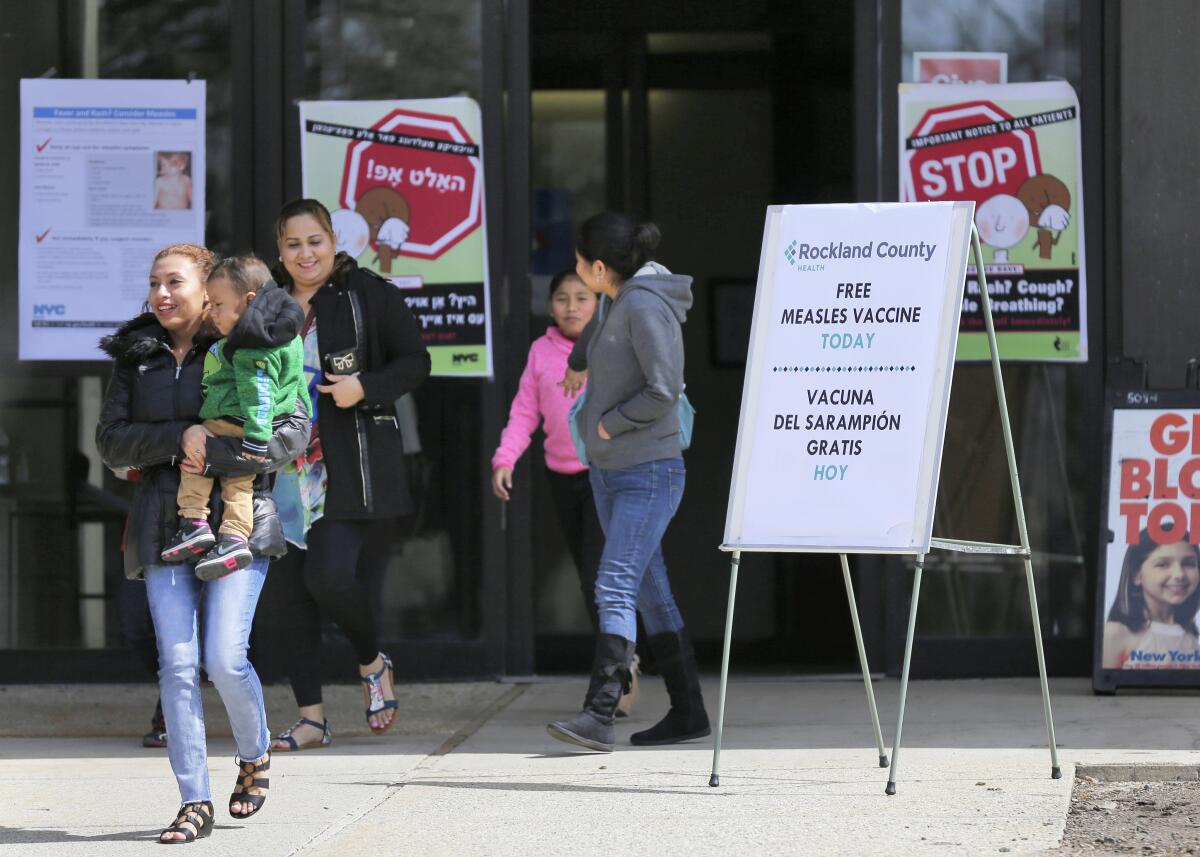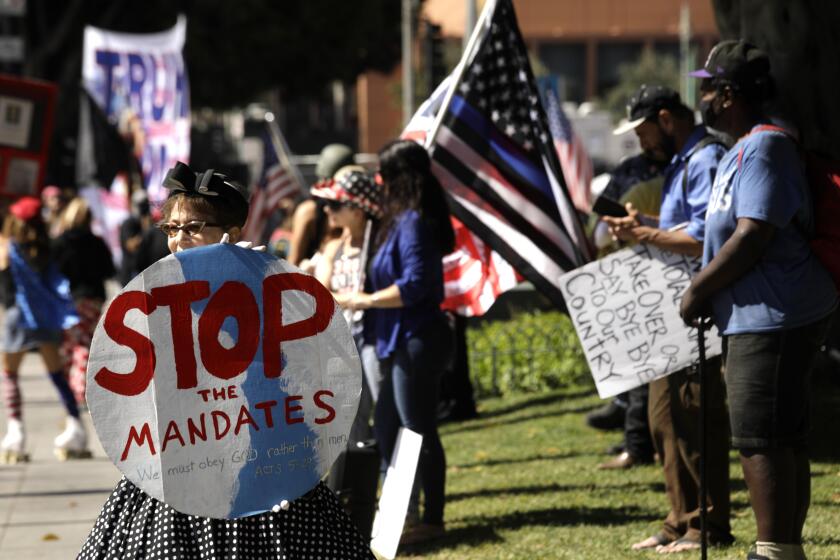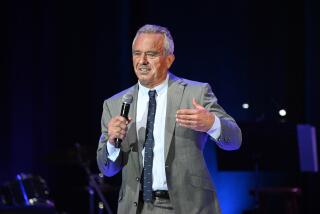Op-Ed: Vaccine disruptions and mistrust are ramping up measles risk

- Share via
Pandemics have consequences beyond the death and disease directly caused by the novel pathogen. In the 1918 influenza pandemic, more deaths were caused by the pneumococcal bacterium among those made susceptible to bacterial infection by influenza than by the flu itself.
One potential byproduct of the devastating COVID-19 pandemic is the threat of an old scourge: measles. In the United States, two doses of measles vaccines are recommended for all children. These doses are usually administered as the measles, mumps and rubella combined vaccine. The first dose is given at 12 to 15 months of age, and the second dose at 4 to 6 years of age. Schools in all states require measles vaccination for entry, though they allow various medical or nonmedical exemptions.
But early in the pandemic, there were substantial disruptions to routine non-COVID vaccination — including fewer children coming to vaccination appointments, and fewer students enrolling in kindergarten, meaning they skipped the requisite vaccines. Many children who missed their recommended doses still haven’t received them.
Fewer and fewer kids are getting inoculated against old foes like measles and smallpox, thanks to rising propaganda. That problem won’t end when the pandemic does.
The World Health Organization has already warned this year of a “perfect storm” for measles outbreaks worldwide and recorded nearly twice as many global cases in the first two months of 2022 than in 2021.
In one of the country’s most significant public health achievements, the U.S. eliminated measles cases originating within its borders in 2000, thanks to vaccines. Since then, measles has reached the U.S. mainly via Americans returning from abroad, or in secondary outbreaks associated with these importations from other countries.
Yet this public health victory now faces a twofold threat: missed vaccine doses in 2020 and 2021, and growing anti-vaccine views because of opposition to the COVID-19 shots.
Herd immunity against measles was under threat even before the pandemic. Increasing vaccine refusal over the last two decades has created a population of unvaccinated individuals from toddlers to young adults.
Looking at outbreak investigations, my colleagues and I found that from 2000 through 2015 a large majority of measles cases started in people who were unvaccinated despite being vaccine-eligible. More than 70% of these had nonmedical exemptions, i.e. exemptions for religious or philosophical reasons.
In another 2016 study, my colleagues and I estimated that 12.5% of U.S. children and teens were susceptible to measles — accounting for those who had refused or missed vaccine doses, as well as those who were too young to be vaccinated but were not protected through maternal antibodies. Alarmingly, among children 3 years old or younger, about a quarter did not have measles immunity. Since measles is highly infectious and requires very high levels of population immunity to prevent outbreaks, the U.S. was at high risk.
In fact, in the years before the COVID-19 pandemic, large measles outbreaks brought the United States close to revocation of its measles elimination status by the World Health Organization. If COVID vaccine misinformation and opposition ramp up vaccine mistrust in general, as health experts fear, measles vaccination rates in the U.S. could dip below 90% — the approximate childhood rate as of 2019 — and enter the danger zone.
In the U.S. before a measles vaccine became available, the disease was associated with a substantial number of hospitalizations and deaths. Even in the post-elimination era, hospitalizations and need for outbreak control can be costly. A Centers for Disease Control and Prevention review of measles outbreaks between 2001 and 2018 found that the median cost per case was $32,805.
By demonstrating that rigorous enforcement of school vaccine mandates would work in the 1970s, L.A. County had a powerful influence on the country.
And measles infection can depress the immune system for years, hampering the body’s ability to respond to other infections, as was found in a 2019 study that aligned with decades of clinical and epidemiological observations.
The risk of large measles outbreaks is increasing with most COVID mandates ended and international travel resuming largely without enforced restrictions. Public health authorities will be gambling if they do not preempt and prepare for these outbreaks. Past public health emergencies demonstrate the considerable threat: During the 2014-16 Ebola outbreak in West Africa, disruptions in routine vaccination resulted in more children dying of measles than the Ebola virus in some countries.
But there are straightforward ways for federal, state and local authorities to mitigate the risk right now.
Childhood immunization mandates continue to play an important role, but because they are imposed at school entry, they do not cover the younger age groups at highest risk of measles infection and its complications. Just ensuring that the shots reach a high number of the children who become eligible for vaccination this year is not sufficient — those who missed measles doses in the last couple of years should be vaccinated as well.
There needs to be a national “catch-up” campaign to vaccinate those who missed their doses of routine vaccines during the pandemic, with a particular focus on kids younger than 5 (school age). Since mid-2020, many countries have planned catch-up campaigns to reduce the risk of measles and other childhood diseases.
Research indicates that doctors and nurses remain the most trusted source of vaccine information even among the vaccine-hesitant. Any national measles catch-up campaign — led by the CDC in collaboration with state and local health departments — must prioritize healthcare providers’ voices and patient interactions for strong public health communication, especially since anti-vaccine misinformation is a growing problem.
The COVID-19 pandemic has already taken a heavy toll on children. We can prevent further damage by stopping the return of an already vanquished foe.
Saad B. Omer is the director of the Yale Institute for Global Health and a professor at the Yale University schools of medicine and public health. @SaadOmer3
More to Read
A cure for the common opinion
Get thought-provoking perspectives with our weekly newsletter.
You may occasionally receive promotional content from the Los Angeles Times.












